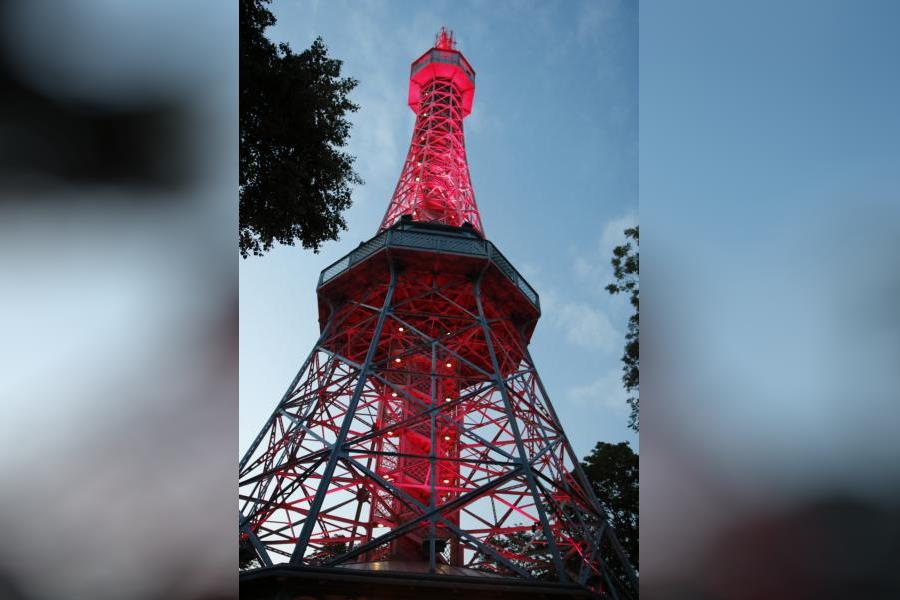Prague’s Petřín Tower will be lit in red in the night from Friday to Saturday, April 17–18, as part of the international celebrations of World Hemophilia Day. Major buildings around the world will be dressed in red, and people are asked to wear red clothes.
World Hemophilia Day is celebrated annually on April 17. Hemophilia is a hereditary disease that inhibits blood clotting. It mostly occurs in men, while women often act as carriers without illness.
“We consider lighting of the 65-meter-tall Petřín Tower in color when it is important to turn the public’s attention to a certain topic, significant day or event. According to available surveys, more than half of Czechs do not know what hemophilia is, how it manifests itself or how people live with this disease,” City Councilor Jan Chabr (United Force for Prague) said.
He considers the red illumination of the lookout tower as a symbol of understanding and compassion for people suffering from this disease. “Even at the height of the pandemic there are a number of other issues that we should not forget,” he added.

Lighting of the Petřín Tower will be provided by the municipal firm Technologie hlavního města Prahy (THMP), which is also responsible for the architectural lighting of 140 Prague monuments.
“Our technician first prepares color schemes on the computer in the office and then uploads them to the scenic computer on Petřín. This will set the color composition of the lookout tower,” THMP board chairman Tomáš Jílek said.
“The system does not work online yet, but this year we want to supplement the lookout with communication with the control room. This will allow us not only to change the color composition of the look-out tower directly from the control table, but also to remotely diagnose individual lights and react to any defect,” he added.
World Hemophilia Day is celebrated annually on April 17. Hemophilia is a hereditary disease that inhibits blood clotting. It mostly occurs in men, while women often act as carriers without illness.
Among the most famous carriers of this disease was the Britain’s Queen Victoria, who can trace hereditary transmission of the disease to the Russian ruling family as well as noble families in Germany and Spain.
The Petřín Tower is the only one of Prague’s monuments to be lit all night. “Because it is located outside the residential area, its lighting does not disturb anyone. We also emphasize that lighting the lookout tower does not cause excessive light smog. Therefore, flashing lights or various more complicated effects are not used too much during the ceremonial lighting, even though the technology allows it,” Chabr said previously.
The tower on top of Petřín Hill since 2015 has been equipped with the 40 LED bank spread out on four levels. It had been lit in colors previously, but the special colors had to be installed and operated manually The banks can each be lit in a variety of colors, without the need to add color filters to the lights.
The Petřín Tower (Petřínská rozhledna), sometimes called the Little Eiffel Tower, opened to the public on Aug. 20, 1891. The idea to build the tower was launched in 1889 by members of the Club of Czech Tourists who had visited the Exposition Universelle in Paris, where they saw the actual Eiffel Tower.
In 1889, the tourist club members set out to raise money from the public and get permission from the city to build the tower in time for the 1891 General Land Centennial Exhibition, which also saw the construction of new buildings at Výstaviště in Holešovice. The funicular in Petřín was built at the same time.
The foundation reaches 11 meters below ground, and overall some 175 tons of steel was used. Inside there were 299 steps and a gas-powered elevator. Originally the tower had a copy of the Czech crown on top. The tower top was damaged by fire in July 1938. In 1953 it became a TV tower and antennas were installed. It remained a TV tower until the Žižkov Tower started operation in 1992. The tower was fully renovated in 1999.
The tower actually has little in common with its Parisian namesake. The Prague tower has an eight-sided base, while the Paris one is on a square base. The Prague version is also smaller, just 63.5 meters tall compared to 324 meters for the original. Petřín Hill, though, rises to 318 meters, so the height of the observation decks of both above the respective city’s basic ground level is comparable.












 Reading time: 3 minutes
Reading time: 3 minutes 


























